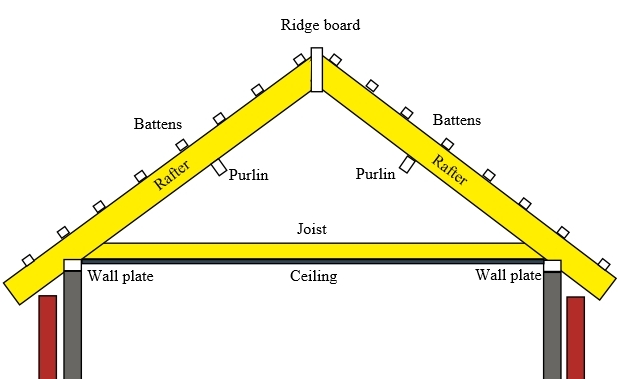Rafter

|
A rafter is a structural component that is used as part of a roof construction. Typically, it runs from the ridge or hip of the roof to the wall plate of the external wall. Rafters are generally laid in series, side by side, providing a base to support roof decks, roof coverings and so on.
Rafters are typically made of timber or steel and can be concealed within the roof structure, or can be left exposed to the spaces below. The may have battens laid on top of and perpendicular to them, to fix the roof covering to.
Rafters can be used as a key component of various types of roof design. The couple roof comprises two rafters leaning against each other, tied where they meet at the top. The rafters sit on a wall plate which is an efficient means of spreading the load exerted by the roof structure down through the walls without creating pressure points where each rafter meets the wall.
A closed couple roof adds ceiling joists running horizontally between the rafter feet, to support a ceiling and to make the structure much more rigid.
In order to increase potential roof spans without compromising wall stability, increasing rafter sizes or attracting extra costs, purlins were introduced. These run perpendicular to rafters, providing additional stiffness. By installing a purlin into the roof structure, rafters no longer needed to be as thick and heavy, allowing larger potential spans.
In modern house construction, the most common form of rafter is known as the fink or 'w' trussed rafter. This consists of a rafter incorporating tension and compression members in the shape of a W. This is capable of spans up to 12 m and can be designed to accommodate many different pitch angles.
For more information see: Trussed rafters
The most common types of rafter include:
- Principal rafter: Usually the largest type of rafter located at the ends of a roof structure.
- Common rafter: Smaller rafters located in between the principals at both ends.
- Auxiliary rafter: Less common but can be used to support and reinforce a principal rafter.
- Compass rafter: Curved or bowed at the top or at both the top and bottom surfaces.
- Curb rafter: The upper rafters in a gambrel or Mansard roof.
- Hip rafter: Smaller rafters used for the corners of a hip roof.
- King rafter: On the side of a hip roof, a king rafter is the longest and is in line with the ridge.
- Valley rafter: The main rafter that is found at the lowest point of a valley roof.
- Jack rafter: A rafter that is shortened by landing on a hip rafter or being interrupted by a dormer window.
- Barge rafter: On a gable end this is the outermost rafter and is sometimes used to form a roof overhang.
[edit] Related articles on Designing Buildings Wiki
Featured articles and news
RTPI leader to become new CIOB Chief Executive Officer
Dr Victoria Hills MRTPI, FICE to take over after Caroline Gumble’s departure.
Social and affordable housing, a long term plan for delivery
The “Delivering a Decade of Renewal for Social and Affordable Housing” strategy sets out future path.
A change to adoptive architecture
Effects of global weather warming on architectural detailing, material choice and human interaction.
The proposed publicly owned and backed subsidiary of Homes England, to facilitate new homes.
How big is the problem and what can we do to mitigate the effects?
Overheating guidance and tools for building designers
A number of cool guides to help with the heat.
The UK's Modern Industrial Strategy: A 10 year plan
Previous consultation criticism, current key elements and general support with some persisting reservations.
Building Safety Regulator reforms
New roles, new staff and a new fast track service pave the way for a single construction regulator.
Architectural Technologist CPDs and Communications
CIAT CPD… and how you can do it!
Cooling centres and cool spaces
Managing extreme heat in cities by directing the public to places for heat stress relief and water sources.
Winter gardens: A brief history and warm variations
Extending the season with glass in different forms and terms.
Restoring Great Yarmouth's Winter Gardens
Transforming one of the least sustainable constructions imaginable.
Construction Skills Mission Board launch sector drive
Newly formed government and industry collaboration set strategy for recruiting an additional 100,000 construction workers a year.
New Architects Code comes into effect in September 2025
ARB Architects Code of Conduct and Practice available with ongoing consultation regarding guidance.
Welsh Skills Body (Medr) launches ambitious plan
The new skills body brings together funding and regulation of tertiary education and research for the devolved nation.
Paul Gandy FCIOB announced as next CIOB President
Former Tilbury Douglas CEO takes helm.
UK Infrastructure: A 10 Year Strategy. In brief with reactions
With the National Infrastructure and Service Transformation Authority (NISTA).






















